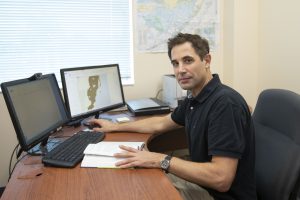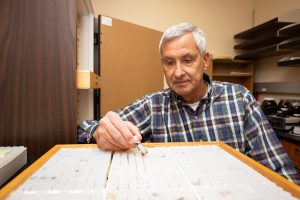
A University of Florida study published in Biological Invasions provides a one-of-a-kind evolutionary map and timeline that reconstructs the historical spread of the Asian subterranean termite over 22 years on Key West.
“Although many islands have been invaded by exotic termites worldwide, this was a unique situation, unprecedented from the onset, to follow the establishment of an invasive termite until it reached complete island domination,” said Rudolf Scheffrahn, an entomology professor at the UF Institute of Food and Agricultural Sciences (UF/IFAS) Fort Lauderdale Research and Education Center (FLREC).
The first Asian subterranean termite infestation in the United States was discovered in Miami in 1996 and has since become a more destructive pest than drywood termites on the South Florida mainland, said Scheffrahn.
By 1999, the appearance of termites in Key West began a profound change with the first discovery of subterranean termites in a waterfront home. It was then that Scheffrahn identified it for the first time from a sample collected by a local pest control operator. Within a few years, he identified a half dozen in Key West homes, then in boats and in trees.
“This study also demonstrates how the merging of two quite distinct research disciplines, entomology and geomatics, can lead to novel insights helpful for the pest control industry, the public and administrative agencies that provide an interpretation and story behind observed termite infestation patterns through Geographic Information System-based science,” said Hartwig “Henry” Hochmair, a co-author and professor of geomatics at FLREC.
For co-author and Key West local Mark Weinberg, the study is a real-world example of how an infestation can dominate an isolated area and then move to new areas.
“This study serves as a critical example of just how easy it is for a species to spread, primarily when a community does not take precautions for property, such as examining boats for infestations,” said Weinberg.

In 2003, Weinberg, owner of Hammerhead Termite Control in Big Pine Key, and Scheffrahn began a partnership to track the spread of Asian subterranean termites on Key West. “It was clear that the termites were not spreading by swarms alone but were being carried to other parts of the island by movement of infested boats,” said Weinberg.
By 2005, Weinberg and Scheffrahn identified 30 infestations, mostly on adjacent Stock Island and the eastern “New Town” neighborhood of Key West. Unlike drywood termites, Asian subterranean termites in buildings cannot be controlled by fumigation. Instead, they require ground-based treatments.

The exact locations and dates of the infestations were recorded. It didn’t take long to see the initial signs of saturation during the process of surveying and treating the termites, said Weinberg.
By 2021, a total of 1,703 site infestations were recorded by the pair. Hochmair became involved in the project to statistically assess the means and spread of Asian subterranean termites over time and space.
“Each analytical method addressed a different aspect, such as where the infestation started, and how the size of infested areas and spatial spread of termites changed over time,” said Hochmair.
Hochmair also worked with the data to predict the infestation spread through a process known as stochastic spread modeling. Scientists use this process to help forecast situations involving uncertainties such as the movement and coverage of a species infestation.
“The termite infestation spread faster than expected based on the spread model, which gives cause to think about additional infestation sources or unknown or hidden infestation spots such as trees that were not inspected in our study,” said Hochmair.
###
By Lourdes Mederos, rodriguezl@ufl.edu
ABOUT UF/IFAS
The mission of the University of Florida Institute of Food and Agricultural Sciences (UF/IFAS) is to develop knowledge relevant to agricultural, human and natural resources and to make that knowledge available to sustain and enhance the quality of human life. With more than a dozen research facilities, 67 county Extension offices, and award-winning students and faculty in the UF College of Agricultural and Life Sciences, UF/IFAS brings science-based solutions to the state’s agricultural and natural resources industries, and all Florida residents.
 4
4
